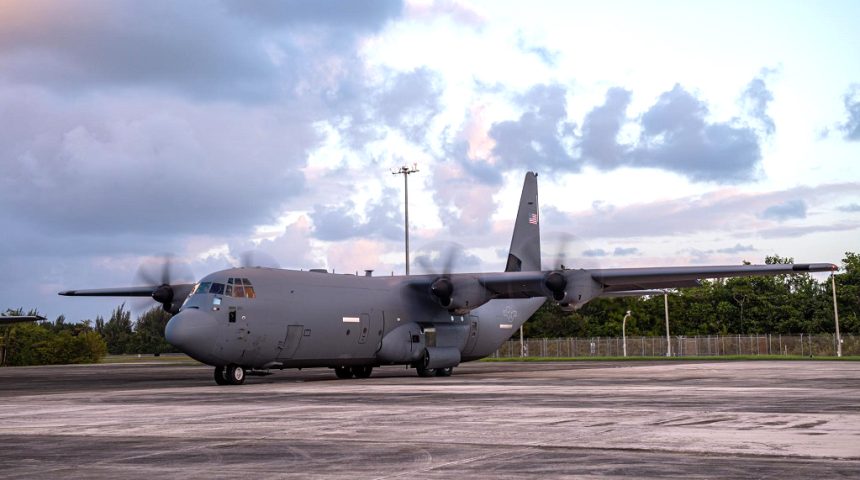C-130s and KC-135s have been spotted flying in a plain grey livery with low-visibility USAF roundels and a small US flag on the tail.
The U.S. Air Force Air Mobility Command is making a drastic change to its fleet of cargo and tanker aircraft, removing all identification markings, including tail numbers, tail flashes, unit markings and the iconic U.S. Air Force writing usually found on the fuselage. The AMC, in fact, decided to remove all the identifying information from aircraft for operational security (OPSEC) reasons, leaving the aircraft wearing a plain grey livery with a small US flag on the tail and low-visibility USAF roundels.
“We operate across the globe every day, often supporting sensitive movements of people and cargo. Understandably, we have concerns about the operational security impacts to these missions in the modern era of on-demand, real-time information,” AMC says in a statement. “Subdued paint schemes that limit identifiable information is one way we are taking a hard look at how we operate to ensure our ability to continue to deliver for America and our allies and partners around the world.”
Photos published on the DVIDS (Defense Visual Information Distribution Service) network already show C-130Js and a KC-135 with the removed markings in February. The C-130s are deployed to Puerto Rico supporting Operation Forward Tiger, an Air Forces Southern exercise designed to increase combat readiness alongside humanitarian assistance and disaster response capabilities with U.S. partners and allies throughout the Caribbean. The KC-135 is flying with the 509th Weapons Squadron, a geographically separated unit of Nellis AFB’s 57th Wing, at Fairchild Air Force Base.
AMC already did a similar, but less radical, change when the KC-46 was fielded and it was decided to remove tail flashes to make it easier for aircraft to move between units without having to be repainted. This new change comes just a month after Air Mobility commander Gen. Mike Minihan told his service members to prepare for a war with China in the next two years and while the command is working to get a more active role in the fight, using its aircraft to launch cruise missiles and drones.

Government watchdog groups and transparency advocates are already considering this move as alarming and puzzling, saying the move is making information less available to the public for a seemingly unclear and unjustified reason. Some of these groups mentioned that this trend in the decrease of information released to the public has been going on for years and getting worse, making it difficult for civil society organizations to be able to monitor the US military.
While the marking’s policy change might make it more difficult to track visually the AMC aircraft, there is still the ADS-B system. Each aircraft is linked to a unique ICAO hex code for identification and many open-source intelligence aircraft trackers built databases with the relevant info for each aircraft. AMC aircraft are usually visible on flight tracking websites and trackers always keep an eye out for them, as their movements can give out precious info.
For an instance, in January 2020 online tracking provided a look at the buildup of US forces in Middle East that followed the attack on the US embassy in Baghdad. The same happened a year later with the withdrawal from Afghanistan, where aircraft evacuating military personnel and refugees were trackable as they left Afghanistan and flew to Kuwait and Qatar before moving on to their destination. So, unless the AMC leadership changes the policies regarding Mode-S and ADS-B, the aircraft will still be trackable with ease.
Curiously, the #Israel Air Force appears to have removed all national markings from at least one of its C-130J-30 ‘#Shimshon‘ (Hebrew for Samson) airlifters. Compare aircraft 661 seen during its rollout, to image of 668 released today by IAF… pic.twitter.com/C9FarWFS0N
— Gareth Jennings (@GarethJennings3) June 4, 2020
No national markings on @armeedeterre Tigres either, not a thing to suggest its French. pic.twitter.com/VnVYCwMvHS
— Tony Osborne (@Rotorfocus) June 4, 2020
It is worth noting that the reduction of identification markings in not unprecedented. Air Force Special Operations Command’s aircraft fly with minimal markings, usually only low visibility USAF roundels, a small USAF writing and the tail number. Other air forces did the same on the other side of the world, like France removing national markings on some VIP aircraft and Tiger helicopters, Israel removing national markings from C-130s, UAE removing national markings from A330MRTTs and C-17s, Italy removing serial numbers from some C-130s, and the list could go on with many more.
In the past, for instance during Operation Desert Storm, aircraft of some air forces, operated over Kuwait and Iraq without markings or subdued ones, including the Italian Air Force Tornado IDS, which were stripped off the individual codes and squadron insignia (and given a desert paint scheme).










